Konica Minolta PULSOX-300i User Manual

OXYGEN SATURATION MONITOR
PULSOX®-300i
Instruction Manual
This instrument must be used according to the instructions of the doctor.

Safety Symbols
Warnings and precautions noted in this manual and the instrument are indicated by the following markings, designed to prevent accidents caused by erroneous handling of the equipment.
This indicates text consisting of a warning or precaution relating to safety. Please read the text carefully and use the equipment safely.
This indicates an action which is prohibited.
The prohibited action should never be carried out, under any circumstances.
This indicates instructions concerning an action.
Always follow the instructions carefully.
This indicates an action which is prohibited.
Never disassemble the product or unit.
This symbol indicates that has no alarm function is prescribed in IEC60417-5319.
This symbol indicates type BF equipment.
The instrument provide a particular degree of protection against electric shock, particularly the leakage current and reliability of the protective earth connection with an F-TYPE APPLIED PART.
F-TYPE APPLIED PART indicates applied part isolated from all other parts of the instrument to such a degree that the patient leakage current allowable in single fault condition is not exceeded when a voltage equal to 1.1 times the highest rated mains voltage is applied between the applied part and earth.
This symbol indicates D.C.
Authorized Standards
For North America
UL, C_ UL:
|
S |
A |
|
L |
|
C |
|
SI
FIED
Electrical Safety
E112871
For Europe
CE (Medical Device Directive):
This instrument complies with EN60601-1, EN60601-1-2,
EN ISO 14971, EN ISO 13485.
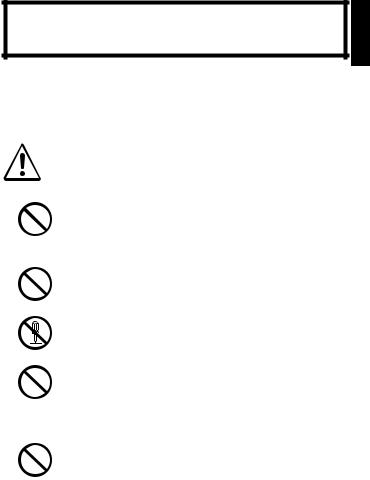
Safety Precautions
To ensure correct use of this instrument, read the following points carefully and adhere to them. After you have read this manual, keep it in a safe place where it can be referred to anytime a question arises.
Foreword
WARNING
(Failure to adhere to the following points may result in death or serious injury.)
The instrument is designed for measurement of the oxygen saturation (SpO2) of arterial blood and the pulse rate. Do not use it for any other purposes, such as warning of sleep apnea and breathing abnormalities.
Do not use the instrument in places where flammable or combustible gases (anesthetic gas etc.) are present. Doing so may cause a fire.
Do not disassemble or modify the instrument and accessories. Doing so may cause a fire or electric shock.
The instrument should not be operated if it is damaged, or smoke or odd smells occur. Doing so may result in a fire. In such situations, turn OFF the power immediately, remove the battery, and contact the nearest authorized service facility.
Do not put the batteries on a fire, short-circuit them, heat them or disassemble them. Doing so may cause explosion or heat generation, resulting in fire or injury.
1
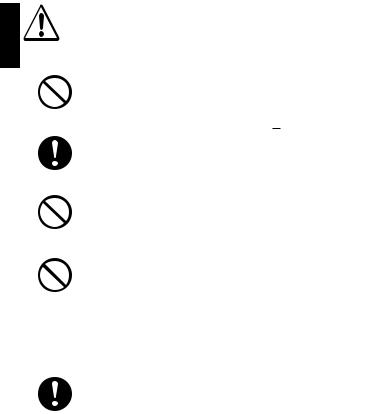
Foreword
CAUTION
(Failure to adhere to the following points may result in injury or damage to the instrument or other property.)
Do not use batteries other than those specified by KONICA MINOLTA SENSING, INC. When installing batteries in the instrument, make sure that they are correctly oriented according to the 
 mark.
mark.
If alkali fluid from the battery comes in contact with eyes, skin, or clothing, immediately wash the affect-
ed area and see a physician for treatment.
Do not use probes other than those specified by KONICA MINOLTA SENSING, INC. Use of alternative probes may cause the probe to overheat, result-
ing in burns.
Do not operate the instrument for long periods of time with a probe attached to a patient. Lowtemperature burn, redness or rash may result. If you feel pain or itchiness, stop use of the instrument immediately and consult a doctor. A doctor should also be consulted before using the instrument on patients with high fever, those with peripheral blood circulation problems or those with sensitive skins.
When attaching the probe to a patient for use during sleep, care must be taken to avoid the cable from becoming twisted around the neck of the patient, for instance when he/she turns over.
2

Contents |
|
Safety Symbols |
|
Safety Precautions.............................................................. |
1 |
Foreword............................................................................. |
4 |
Safety Notes............................................................................ |
4 |
Package Contents................................................................... |
5 |
About Probe............................................................................. |
5 |
System Diagrams and Accessories......................................... |
6 |
Names of Parts........................................................................ |
7 |
Notes on Use........................................................................... |
8 |
Notes on Storage................................................................... |
10 |
Disposal Method.................................................................... |
11 |
Preparations...................................................................... |
12 |
1) Attaching the Wrist Band................................................... |
12 |
2) Connecting the probe........................................................ |
14 |
3) Installing the battery.......................................................... |
15 |
4) Attaching the PULSOX to the wrist.................................... |
16 |
Measurement.................................................................... |
17 |
1) Starting the Measurement (Power ON)............................. |
17 |
2) Reading the display........................................................... |
19 |
3) Ending the Measurement (Power OFF)............................ |
20 |
About Auto Power-Off function.............................................. |
20 |
Regarding the memory function............................................ |
20 |
External Connection.......................................................... |
21 |
Trouble Shootings............................................................. |
23 |
Error Messages..................................................................... |
23 |
Check Points before repairing............................................... |
28 |
Maintenance and Inspection.................................................. |
28 |
Cleaning................................................................................ |
28 |
Specification...................................................................... |
29 |
Appendix........................................................................... |
31 |
Calculation Method for Displayed Values.............................. |
31 |
EMC Guidance...................................................................... |
32 |
Measurement Principle.......................................................... |
34 |
Relation between Oxygen Saturation and partial Pressure............... |
35 |
Foreword
3
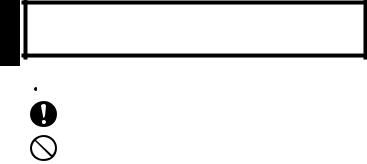
Foreword
Foreword
 Safety Notes
Safety Notes
CAUTION: U.S.Federal law restricts this device to sale by or on the order of a physician.
The instrument is designed for measurement of the oxygen saturation (SpO2) of arterial blood and the pulse rate. Do not use it for any other purposes, such as warning of sleep apnea and breathing abnormalities.
The Oxygen Saturation Monitor PULSOX-300i is designed to measure oxygen saturation (SpO2 value) in arterial blood and pulse rate by attaching a probe to a peripheral part of the body, such as a finger, in a non-invasive method.
PULSOX-300i is intended for continuous data-collection use such as during a sleep study and not for traditional continuous use.
•The compact, lightweight and portable body has a large
LCD for easy operation.
•The LCD has a backlight function, providing high visibility even in dark areas.
•Built-in memory enables storage of up to 300 hours of measured data.
•Use of the optional software allows you to set the date/ time and to set the auto-power-off time on the PULSOX300i. In addition, the measured data stored in the memory can be processed, stored collectively or output via a printer using a personal computer.
4

Package Contents
Before using the instrument, make sure that the following items are present.
1)PULSOX-300i main body × 1
2)Wristband WB-300 × 1
3)AAA-size alkaline battery × 1
4)Instruction manuals
•PULSOX-300i instruction manual × 1
•Separate manual (Using manual for Probes) × 1The probe is optional.
About Probe
The following probe types can be used with this instrument.
•Finger Clip Probe SR-5C
•Spot Check Probe SP-5C
•Monitor Probe LM-5C
•Personal Probe SD-5C
As shown in the table below, the measuring point varies with the probe used, so select the one that is suitable for your purpose.
Probe type |
Patient |
Allowed measuring point |
|
SR-5C |
|
|
|
SP-5C |
Adult |
Finger (hand) |
|
LM-5C |
|||
|
|
||
SD-5C |
|
|
For the usage method, please refer to “Connecting the probe” (page 14) on this manual and the probe’s instruction manual.
Foreword
5
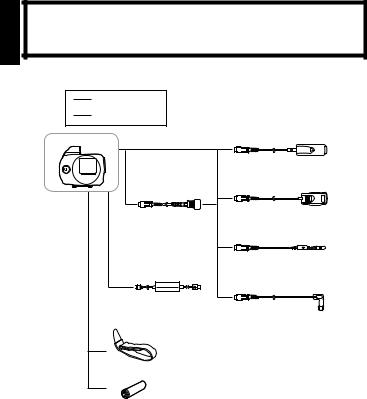
Foreword
System Diagrams and Accessories
The instrument consists of the following items.
Standard accessories
Optional accessories
Optional accessories
05,3/8 I |
|
Finger Clip Probe SR-5C |
|
|
|
|
Extension cable EC-300 |
Spot Check Probe SP-5C |
|
|
|
|
|
Monitor Probe LM-5C |
|
USB adapter UA-300 |
|
|
|
Personal Probe SD-5C |
Standard accessories
Wristband WB-300
AAA-size alkaline battery
6
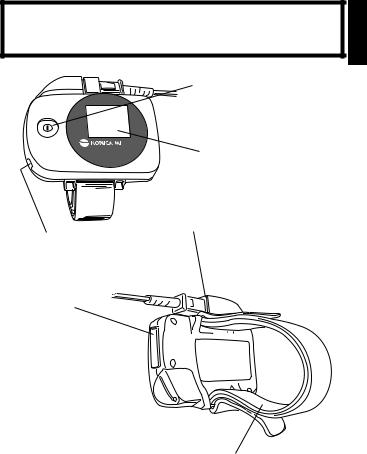
Names of Parts
PULSOX
Backlight button
Press it to turn ON the backlight of the LCD.
External output terminal
Connect the optional USB adapter “UA-300” to connect the instrument to a personal computer.
Battery cover 
The cover can be opened by turning it approximately 90 degrees.
Power button
Used to start measurement ( P o w e r - O N ) o r e n d measurement (Power-OFF).
LCD Display
(with the backlight function)
Measurement results and messages are displayed.
Probe connector
Connect the probe or extension cable EC-300 to this connector.
Wristband
Used to set the instrument on your wrist.
Foreword
7

Foreword
Notes on Use
•This instrument should be used under the following operating conditions.
•Temperature of 0 to 40°C (32 to 104°F), relative humidity of 30 to 85%, with no condensation.
•Atmospheric pressure of 700 to 1060 hPa (altitude of
–400 to 3000m).
•This is a precision instrument. To avoid the possibility of it being damaged, the instrument should not be dropped nor should heavy objects be placed on top of it.
•Do not expose this instrument to rain and water.
•This instrument has no alarm function. Do not use this instrument if an alarm function is necessary.
•This instrument is designed for use on adults. When using the instrument on infants or babies, please note that the designed measurement accuracy cannot be guaranteed.
•Do not use the instrument on a point where there is excessive vibration. In addition, to avoid excessive impact on the instrument, it should be handled gently. Failure to observe this may cause breakdown.
•A maximum of 300 hours of measurement data can be stored, or the maximum storable number of data files is 399 files. If measurements are continued after the maximum number of storable data has been reached, the new data will overwrite the oldest data. To keep data, be sure to download it before the memory becomes full.
•Accurate measurement data may not be obtained in the following cases.
•When body movement is excessive
•When the probe is not attached properly
•When blood circulation at the measuring point is poor (due to pressure on arm/finger, peripheral circulatory insufficiency)
•When ambient light (e.g. panel light, fluorescent light, infrared heat lamp, direct sunlight) is too strong
8

|
|
|
|
|
|
|
|
|
|
• |
When influenced electromagnetically by other electronic de- |
|
|
Foreword |
|
|
|
|
vices (e.g. near electrical appliances like TV, medial device) |
|
|||
|
|
|
|
|
|||
|
|
• |
When a mobile telephone is used during measurement |
|
|
||
|
|
• |
When influenced by abnormal hemoglobin like carbon |
|
|
||
|
|
|
|
|
|
||
|
|
|
monoxide hemoglobin (HbCO) and methemoglobin |
|
|||
|
|
|
|
||||
|
|
• |
When pigments such as cardiogreen, intravascular dyes |
|
|||
|
|
|
and indocyanine greenare present in the blood |
|
|||
|
|
• |
When finger nails are polished |
|
|||
|
• Tables 1 and 2 below show the errors which may occur due to |
|
|||||
|
|
these hemoglobins. |
|
|
|
|
|
|
|
|
Difference from the SaO2 value to displayed value |
|
|||
|
|
|
<Table 1> |
<Table 2> |
|
||
SaO2 |
|
HbCO |
|
|
1% |
5% |
10% |
||
|
||||
50 |
-0.1 |
-0.7 |
-1.5 |
|
70 |
-0.1 |
-0.7 |
-1.5 |
|
90 |
-0.2 |
-0.8 |
-1.6 |
|
100 |
-0.2 |
-0.8 |
-1.7 |
Measured value is always lower than the actual value.
SaO2 |
Methemoglobin |
|||
1% |
5% |
10% |
||
|
||||
50 |
+0.2 |
+1.3 |
+3.2 |
|
70 |
-0.6 |
-2.3 |
-3.2 |
|
90 |
-1.5 |
-6.0 |
-9.6 |
|
100 |
-1.8 |
-7.5 |
-12.2 |
|
Displayed value is sometimes higher than the actual value if SaO2 is around 50%.
•Do not immerse the probe, the extension cable or the connecter of PULSOX-300i in disinfectant. Doing so may cause a malfunction.
•When using the Extension Cable EC-300, fit and secure cables so they are not too loose or too tight.
•Before connecting to a personal computer, remove the Pulsox from the patient.
9

Foreword
Notes on Storage
•This instrument should be stored under the following storage conditions.
•Temperature of –10 to 60°C (14 to 140°F), relative humidity of 10 to 95%, with no condensation.
•Atmospheric pressure of 700 to 1060 hPa (altitude of –400 to 3000m).
•When storing the instrument:
•Do not store the instrument in an area where it will be exposed to water.
•Do not store the instrument in an area where direct sunlight, pressure, temperature, humidity, ventilation, sunlight, dust, strong magnetic fields, and/or saline or sulphurous atmospheres may affect the instrument.
•Do not store the instrument on an inclined surface or on a surface which may be subject to vibrations or physical shock. (Also avoid vibrations or physical shock during transportation.)
•Do not store the instrument in areas where chemicals are stored or where gas may be emitted.
•To avoid any problems occurring the next time the instrument is used, make sure the instrument, cords, probes and other accessories are cleaned and stored safely.
•If the instrument will not be used for more than 2 weeks, remove the batteries from the battery to avoid the possibility of damage due to leakage of electrolyte.
•The time/date set to the instrument using the optional software will be reset to the factory setting (Jan. 1, 2000/0:00) if the instrument is left for more than one day without the battery.
•The measurement data and the auto power-off time set to the instrument using the optional software will be kept even if the instrument is left without the battery.
10
